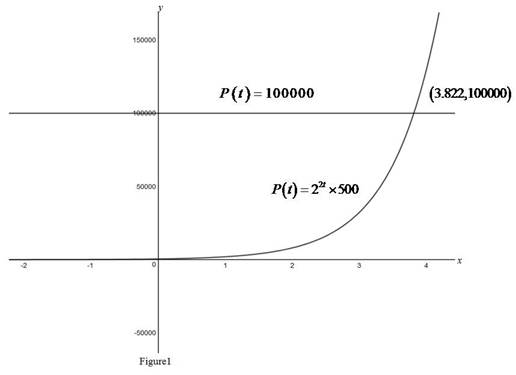
Concept explainers
A bacteria culture starts with 500 bacteria and doubles in size every half hour.
(a) How many bacteria are there after 3 hours?
(b) How many bacteria are there after t hours?
(c) How many bacteria are there after 40 minutes?
(d) Graph the population function and estimate the time for the population to reach 100,000.
(a)
To Find: The population of bacteria after 3 hours.
Answer to Problem 30E
There are 32,000 bacteria after 3 hours.
Explanation of Solution
Given:
The initial population of bacteria is 500 and it gets double for every half hour.
Calculation:
Using the given initial population of bacteria
Therefore,
Substitute
Therefore, there are 32,000 bacteria after 3 hours.
(b)
To find: The population of bacteria after t hours.
Answer to Problem 30E
There are
Explanation of Solution
Given:
The initial population of bacteria is 500 and it gets double for every half hour.
Calculation:
Using the given initial population of bacteria
Therefore,
Substitute
Therefore, there are
(c)
To Find: The population of bacteria after 40 minutes.
Answer to Problem 30E
There are 1260 bacteria after 40 minutes.
Explanation of Solution
Given:
The initial population of bacteria is 500 and it gets double for every half hour.
Calculation:
Using the given initial population of bacteria
Therefore,
Convert the given time into hour as shown below,
40minutes =
Substitute
Therefore,. there are 1260 bacteria after 40 minutes.
(d)
To estimate: The time for the population
Explanation of Solution
Graph:
Use online graph calculator and draw the graph of the functions

From Figure 1, the curve intersects the line
That is, t=3.822 when
Therefore it takes 3.822 hours to reach to 100000 to the population.
Chapter 1 Solutions
Single Variable Calculus: Concepts and Contexts, Enhanced Edition
Additional Math Textbook Solutions
Precalculus: A Unit Circle Approach
Advanced Mathematical Concepts: Precalculus with Applications, Student Edition
Calculus and Its Applications (11th Edition)
University Calculus
Precalculus Enhanced with Graphing Utilities (7th Edition)
Calculus, Single Variable: Early Transcendentals (3rd Edition)
 Calculus: Early TranscendentalsCalculusISBN:9781285741550Author:James StewartPublisher:Cengage Learning
Calculus: Early TranscendentalsCalculusISBN:9781285741550Author:James StewartPublisher:Cengage Learning Thomas' Calculus (14th Edition)CalculusISBN:9780134438986Author:Joel R. Hass, Christopher E. Heil, Maurice D. WeirPublisher:PEARSON
Thomas' Calculus (14th Edition)CalculusISBN:9780134438986Author:Joel R. Hass, Christopher E. Heil, Maurice D. WeirPublisher:PEARSON Calculus: Early Transcendentals (3rd Edition)CalculusISBN:9780134763644Author:William L. Briggs, Lyle Cochran, Bernard Gillett, Eric SchulzPublisher:PEARSON
Calculus: Early Transcendentals (3rd Edition)CalculusISBN:9780134763644Author:William L. Briggs, Lyle Cochran, Bernard Gillett, Eric SchulzPublisher:PEARSON Calculus: Early TranscendentalsCalculusISBN:9781319050740Author:Jon Rogawski, Colin Adams, Robert FranzosaPublisher:W. H. Freeman
Calculus: Early TranscendentalsCalculusISBN:9781319050740Author:Jon Rogawski, Colin Adams, Robert FranzosaPublisher:W. H. Freeman
 Calculus: Early Transcendental FunctionsCalculusISBN:9781337552516Author:Ron Larson, Bruce H. EdwardsPublisher:Cengage Learning
Calculus: Early Transcendental FunctionsCalculusISBN:9781337552516Author:Ron Larson, Bruce H. EdwardsPublisher:Cengage Learning





